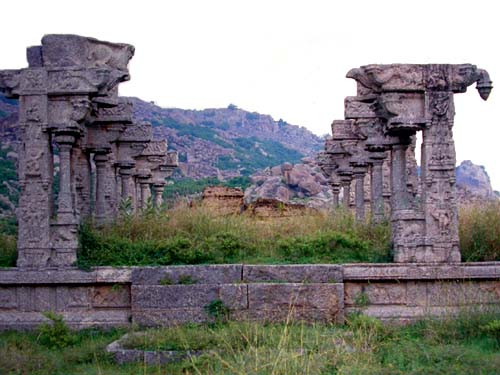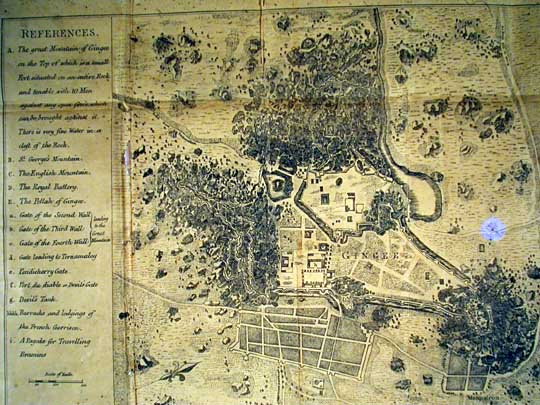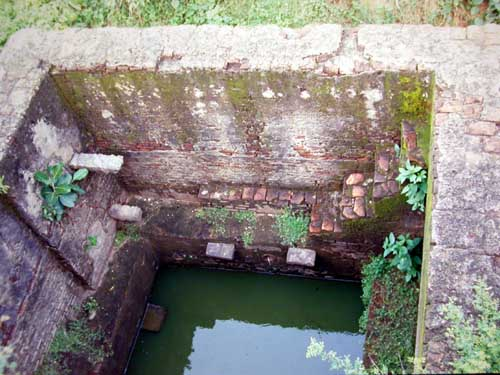Dec 13, 2025
Dec 13, 2025
Tamil Nadu Lags in Promoting Historical Tourism
The silent revolution by French institutions in Pondicherry is not being noticed with requisite interest. Professor M. Bourdat of Lycee Francaise in his book 18th Century Pondicherry published in 1992 writes about Inland Forts, but fortunately the task to write about Senji (Gingee) falls on the shoulders of Jean Deloche of the Ecole Francaise D'Extreme-Orient and he had produced a monumental work in his mother tongue French entitled "Senji (Gingi) Ville fortifie'e du pays Tamoul".
English version of this book had also appeared. Then it will take decades to see it in Tamil.
To know about the history of a Fort situated in Tamil Nadu, more than the Universities and Research Institutions here the, French institute called Ecole Francaise D'Extreme Orient had been rendering valuable services, which must be lauded with deep sense of gratitude. The archeological excavations of Arikamedu brought out in a book by Vimala Begley and titled "The Ancient Port of Arikamedu Vol I" is yet to be translated into Tamil. Now the French book on Senji by this institute must awaken Indian Research institutions to keep pace and bring both books in Tamil for the benefit of Tamil speaking people.

Far away from Pondicherry the entrance of the Gingee Fort has got a Pondicherry Gate. Similarly Pondicherry has a Gingee Salai, road that leads to Gingee. Why So? It denotes the inseparable historical connectivity between these two places.
French captured Gingee and it remained with the French for almost a decade. The battle for Gingee is vividly portrayed in volume XV of the "Lettres edifiantes et curieuses" written by a Jesuit priest Father Lavaur.
"On September 11, 1750 Bussy and d'Auteuil arrived at the scene of battle towards 7 o'clock in the evening. While the besieged opened fire in un-coordinated fashion French artillery contained them within their cover. When the moon had set, a detachment under the command of three officers scaled the hill of Rajagiri. It is not known how these men were able to clear the deep breach with its drawbridge, which defended the topmost boulder, an enormous natural donjon. Then towards 4 o' clock in the morning, a loud cry was heard coming from the top of one of the mountains. "Vive Le Roll". It was Mm de Saint Georges, Veri and Le Normand who, followed by their troops had carried out the order they had been given. The attack then became general. M d' Fauteuil had the gate of the citadel blown up. Terror spread amongst the defending Moors who fired weekly several times and then fled. In less than an hour one had become master of all."
This how French conquest of Gingee is recorded.
Many have conquered and many have ruled Gingee but a young man known for his bravery is still the hero of Gingee, that too after getting killed in a war. Yes, this brave man Desingh at the age of 22 with just 500 troopers and 350 horses faced an army of 8000 horsemen and 10,000 soldiers. The result he lost his life, his wife got immolated in his funeral pyre. But he lives in history and peoples memory.
Raja Desingh, the film where MG Ramachandiran played Raja Desingh was not well received by the audience because the fans of MGR did not relish the thought of hero dying in a war. But the real hero Raja Desingh is a hero living in folklore, ballads and peoples memory.
The difference in these battles is while French recorded the history of the battle, Tamils wrote folk songs adding their imaginative skills, and that is why historians dismiss these literary evidences unless corroborated with archaeological and other findings.
A question arises to every ones mind. How could a fort that produced the heroic Desingh in later days fall so easily to French? The answer is found in a book of a French scholar who is true to his quest towards truth.
This impregnable fortress had fallen in alien hands and such defeats are made a post mortem by a French scholar Bourdot in his book "18th Century Pondicherry."
quot;It was a revolt amongst the besieged that opened the gates to Bijapur's army. It was an act of treason that enabled the Maharatta Shivaji to take possession of it in 1677. Without the help of corruption the place would never had fallen to the Moghul power twenty years later. Lastly it is doubtful whether Bussy with his 200 men would have been able to succeed in just few hours, with a raid that resulted in the surrender of the garrison, had it not been the panic and terror that could overcome the most courageous of the defenders during a night attack contrary to all rules especially that night was without moon or starts and when the assailants are yelling demoniacally in an unknown tongue".
M.Bourdat deserves due applauds for placing these truths in the pages of history to set the record straight.

Jain Saints had dwelled in the hills of Gingee from 2nd century to 6th centuries, as evident by many stone carvings and other evidences of Gingee being citadel of Jainism. Gingee was under Pallava Emperors between 600 to 900 AD. Chozha Emperors ruled Gingee between 900 to 1103 AD. In the stone epigraphs at Aanangur of Athitya Chozhan (871-907) and of Athiya Chozhan II (985-1013) it becomes crystal clear that Chozha Emperors ruled Gingee.
Pandya Emperors, Chozha Rulers and Hoysala Kings ruled between 1014 to 1190 AD. Yadhava kings ruled Gingee between 1190 to 1330 AD. It came under Vijayanagar rule from the fag end of 14th century and for 150 years it was under Vijayanagar rule.
It came under the rule of Bijapur Sultans between 1649-1677 AD. Maharashtrians ruled from 1677-1697. Moghuls ruled from 1700-1750 AD. It slipped between British and French rule from 1750. This is in nutshell the historical imprints left on Gingee, and for such a Fort which has a history dating back to 1800 years if proper publicity is made abroad it will definitely attract world tourists. It also needs the help of world agencies that protect heritage to improve its infrastructure and other amenities. As an authority on Gingee Professor Jean Deloche describes with passion " the technological skills shown in water management and also in the art of war after the invention of gunpowder."

Professor Jean Deloche elaborates the military architecture angle too with vivid details. According to him, during the rule of Vijayanagar Governors "the construction was based on quadrangular works. Curtain walls were made of segments forming salient angles, flanked by square or rectangular towers. Stonewalls were made of earth and rubble filling, with wedge shaped stone blocks and no mortar in joints except in battlement of stone or brick. Gateways consisted of two rectangular platforms separated by a central passageway. This is the old system of fortification."
Talking to us enthusiastically the Professor is at his best spirit while he narrates about the profound changes brought by Nayaks in their almost 100 year rule –
"in the art of defense, a consequence of the introduction of gun powder into warfare and the development of powerful artillery. It is based on circular and semi circular works, which by establishing a flanking fire, remedied the defects of former constructions. It started with the reshaping of some of the old walls and battlements. Embankments of earth were given a facing of masonry and towers were rounded in the lower fort, almond shaped merlons replaced the older ones"
"The big innovation of the period is the construction of the first enclosure, with semi circular towers, surrounding Krishnagiri and extending to the eastern cliff of Chandrayandurgam, linking the three hills, in the form of a triangle. With extensive use of explosive projectiles and the development of siege artillery, the other mountains Kurangudurgam and Kusumalai were also fortified in the same way, as well as the south west spur of Chandrayanmdurgam, since then called Sakkilidurgam".
"A new defensive system was adopted to protect the gateways. Moreover cavaliers or round structures were raised behind the towers to lend support and provide firing platforms for artillery" This architectural marvel from military point of view and from the general view found expression in the best water management plan of a fort blended together had created a uniqueness and hence Jean Deloche describes that.
The Fort at Gingee declared as National Monument from 1921 is under the Archeological Department. Its history and the archeological finds in its vicinity must be publicized to promote archeological and historical tourism. French scholar Jean Deloche and his publications though are known to scholars must be taken to the common man and Government of India must suitably honor him. But no steps are afoot in governmental promotion of archeological and historical tourism. An Engineer by profession R. Mani had been tirelessly giving a helping hand in preparation of maps and repairs of forts including Gingee fort. He has also penned a book in Tamil " Varaltaril Gingee." This is just a candle while we have to illuminate Gingee's history with 1000 lights. The need to promote historical tourism is yet to gain momentum in India, that is why a fort with 1000 year unbroken history is kept in dark.
13-Jan-2008
More by : N. Nandhivarman

|
nice and good fort and this civil kingdam this fort |

|
I am very interested to know about of chenji port history. But I request to you easy language to understand all kind of people's. I am also belongs once open time this. |

|
can I get the old map photo in hi quality |

|
who founder in this kottai I thing "KOTTALINGA KURUMBAN" IT'S correct or wrong pls replay |

|
realy supper |

|
I am interested in the Nayak rulers of Gingee. I have three lists, each different. Do you have a list of them? Thank you. Stephen |